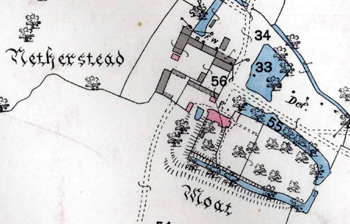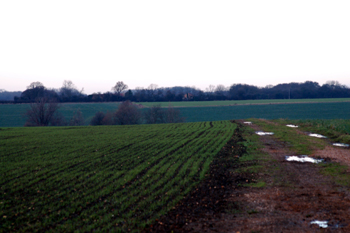Netherstead Farm Colmworth
![Netherstead about 1900 [Z50/32/3]](/CommunityHistories/Colmworth/ColmworthImages/Netherstead Z50-32-3.jpg)
Netherstead about 1900 [Z50/32/3]
Photographs of Netherstead show a large 15th or 16th century farmhouse on the verge of falling down. It was demolished in 1904. The site had a large rectangular moat with an exterior parapet to south and west. By 1966 the moat had been entirely filled in and the area ploughed, and by 1974 only a scatter of building debris indicated the site. The parish boundary between Colmworth and Staploe runs right through the site.
The farm seems to have formed part of Colmworth Manor from earliest times. A messuage called Natherstede is first mentioned in a deed of 1432 [X432/6] showing that the building demolished in 1904 was not the first on the site. In 1432 Reginald Kentwode, a deacon of Saint Paul's Cathedral in London, Joan, widow of Sir William Thirnyng, John Hampden, John D'Arcy, John Inglefield, John Urnell and Richard Valdryan granted Netherstede to John Brayn of Colmworth for life at a rent of a hundred shillings per annum.
In 1742 the Colmworth Estate, comprising The Manor, Lordship Farm [now Manor Farm], Channels End Farm and Netherstead Farm were sold by Thomas Browne and Denis Farrer to Francis Astrey and George Draper [MH3-4]. At that time Netherstead Farm was occupied by John King at a rent of £85 per annum. It may have been his father William who had a private pew installed in the church in 1709. His farm comprised 222 acres.
In 1770 the Colmworth estate was mortgaged by Richard Ray to John Ives of Norfolk for £10,000 [MH17]. At that date Netherstead Farm comprised 240 acres in the occupation of Richard Everett who still paid £85 per annum.

Netherstead Farm in 1884
In 1795 the Colmworth Estate, now also including Church End Farm, today's Church Farm, was sold at auction [MH30-31by Lord of the Manor Richard Ray and was bought by Lincolnshire parson Leonard Towne. Netherstead Farm comprised 240 acres, 3 roods, 5 poles and was let to William Nicholson on a yearly lease at £100 per annum rent. The farm comprised both inclosed and open field land as follows:
- The farmhouse and homestead - 3 acres, 2 roods,8 poles;
- Little Ley Close - pasture of 5 acres, 38 poles;
- Great Ley Close - pasture of 16 acres, 3 roods, 20 poles;
- Burnoe Close - pasture of 32 acres, 2 roods, 38 poles;
- Die Croft - pasture of 5 acres, 2 roods, 33 poles;
- Netherstead Meadow - pasture of 15 acres, 34 poles;
- Great August Field - arable of 24 acres, 3 roods, 2 poles;
- Little August Field - arable of 11 acres;
- Calves' Close - pasture of 4 acres, 32 poles;
- Hill Close - pasture of 4 acres, 2 roods;
- Poulter's Close - pasture of 2 acres, 2 roods, 8 poles;
- Bushey Pightle - pasture of 34 poles.
The common field land was as follows:
- In Long Field 2 acres;
- In East Croft Brook Field, nine parcels totalling 9 acres, 1 rood;
- In Capley Field 1 acrel
- In Broad Mead Field, six parcels totalling 20 acres;
- In Burnoe Field, six parcels totalling 15 acres;
- In Home Field, three parcels totalling 18 acres;
- Long Field 20 acres, 3 roods, 38 poles;
- Crow Ridden Field 26 acres;
- In Colsden Field, two parcels totalling 2 acres.
![Netherstead Farm comprising pink coloured land marked Lot 6 in this sale plan of 1918 [MH60]](/CommunityHistories/Colmworth/ColmworthImages/Netherstead Farm comprising pink coloured land mar_194x300.jpg)
Netherstead Farm comprising pink coloured land marked Lot 6 in this sale plan of 1918 [MH60]
The Colmworth Estate was again sold by auction in 1918 [MH60] and Netherstead Farm then contained 429 acres, 2 roods, 26 poles "of which 24 Acres are thriving Woodlands and including the well-known Colmworth Wood". The farm buildings "adjoin the site of the old Moated 14th Century House, not long since demolished" and comprised a brick, stud and tiled granary; a brick, timber and tiled cow house for eight beasts; a stable for six horses; two loose boxes; a five bay open shed; a four bay open shed; a range of piggeries; a brick and tiled hen house, tool house and store place. The occupier was W. L. Addington, with the exception of a grass field of 25 acres, 38 poles occupied by a man named Ward and an arable field of 6 acres, 2 roods, 34 perches occupied by Frederick Stanton of Channels End Farm. The particulars state: "With this lot will be included the Ancient Manor or Lordship of Colmworth with such rights, privileges, members and appurtenances (if any) still attaching thereto". A succession of law of Property Acts in the 1920s effectively abolished manors in all but name.
The Rating and Valuation Act 1925 specified that every piece of land and building in the country was to be assessed to determine its rateable value. The valuer visiting the site of Netherstead Farm [DV1/H41/40] simply says that the owner and occupier was M. Frost who had Colesden Grange, Hill, Netherstead and Beggary Farms and describes a wood and tile granary, brick, wood and tile shed and three brick and tile henhouses on the site - "remainder fallen".
 Looking north from Mill Road to the site of Netherstead December 2009
Looking north from Mill Road to the site of Netherstead December 2009